Construction
AI Shift Scheduling for Construction: Is This the Future of HR and Payroll?
October 17, 2025 • 85 Views • 36 min read
Bohdan Vasylkiv
CEO & Co-Founder
Construction is undergoing a data and automation awakening. All projects involve numerous data-driven processes, such as subcontractor management, equipment fleet monitoring, or job site tracking. Still, the most essential one is workforce scheduling and administration. Today, we would like to discuss AI shift scheduling and how artificial intelligence can help alleviate the routine burden.
Workforce scheduling is a crucial aspect of any business, enabling the optimal utilization of human resources and enhancing awareness of current activities. Unfortunately, most such operations remain highly manual, primarily relying on spreadsheets, group chats, and unplanned calls. Such an outdated approach makes shift management slower and less efficient, negatively impacting other aspects of everyday routine.
AI shift scheduling offers unique solutions that can help mitigate risks and automate every manual operation that can be streamlined. Such AI-based solutions offer numerous tools and approaches that can significantly enhance the efficiency of your crew and business simultaneously.
However, learning the benefits of such software is not enough. We also need to know how to integrate AI into construction HR software and payroll processes to understand the potential budget and other required resources for such implementation. Knowing this information can help you make an informed decision on whether such agentic artificial intelligence is worth investing in for your particular case.
The State of Scheduling in Construction Today
Let’s start with the basics. Therefore, before embracing AI employee scheduling solutions, we must confront the reality of most construction projects and their management. Once again, most schedules are created and handled manually. Thus, it takes time and effort from project or crew managers to implement changes or simply track the team's progress daily.
Despite this, such an approach has proven its efficiency for a long time; however, it lacks many features and can’t take into account various related factors, such as weather conditions or material delays. So, eventually, the schedule will break down, and managers will have to go into crisis mode to divert crews, trying to mitigate the risks or delays. Additionally, don’t forget about the operational pain points faced daily.
Operational Pain Points You Suffer Each Week
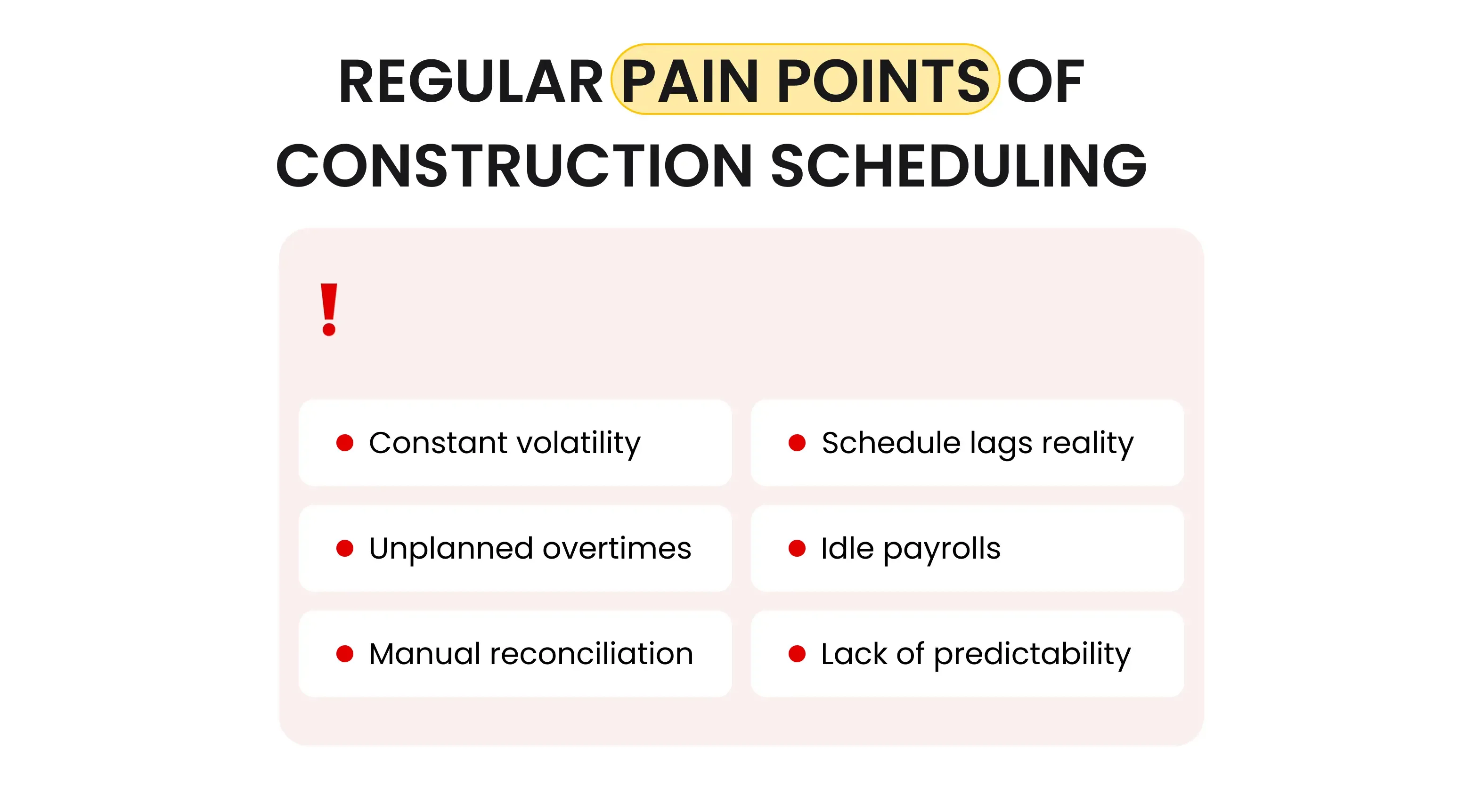
The pain points we are to discuss are recited by heart by most contractors, and they remain consistent across regions and trades. The underlying cause is volatility - labor demand ebbs and flows relentlessly as work gets stuck or bottlenecks.
When the schedules lag reality, crews arrive without work to perform, or critical tasks are under-resourced. The insidious costs include downtime, rework risk, and shattered morale, which are compounded across sites and weeks.
Unplanned overtime is another old symptom. When a project falls behind schedule due to inefficient construction employee scheduling, managers often put in extra hours with the same dependable crew, as they can work with the most excellent performance.
This, in turn, drives up overtime premiums and reduces margins. Idle payroll is its mirror image: finishers or carpenters wait for a preceding trade, wasting paid time without progress. Both tendencies make payroll reconciliation laborious and project variance exaggerated.
Another drawback is the manual reconciliation required among scheduled shifts, timesheets, and payroll exports. HR and payroll personnel sort through exceptions, differentials, and union regulations in arrears. Discrepancies turn into disputes, disputes turn into delays, and no one trusts the numbers any longer.
Still, these are not the only common issues of manual or outdated construction staff scheduling software and practices.
The Human Impact and Retention Risk
Construction labor markets are tight. Laborers evaluate employers as much on fairness and predictability as on rate. When schedules arrive at the last minute or fluctuate wildly, top performers tend to gravitate toward crews that respect their time.
As a result, problematic construction crew scheduling not only impacts deadlines and final project costs but also influences the relationships with top employees or specialists, who value their time.
Alternatively, visible rotation, advance notice, and a path to stable hours foster loyalty. AI shift scheduling can provide managers with tools to offer predictability without compromising productivity goals. Additionally, it facilitates the planning and execution of more efficient and accurate schedules, which helps reduce time and resource wastage.
Compliance, Safety, and Union Realities
Lastly, construction is subject to intricate regulatory and contractual frameworks. This includes jurisdictional labor codes, fatigue regulations, mandatory rest breaks, seniority rights for union members, and certification requirements.
Traditionally, these administrative tasks are performed manually, which requires a significant amount of time and effort from the management team. It suggests a lot of paperwork and advanced planning, which are prone to human factors. An AI staff scheduling tool can significantly boost such processes.
All your management team has to do is provide the virtual assistant with data and detailed explanations of what they expect from the schedule. An intelligent software agent can process input information in under a minute and generate several variations of how to satisfy all demands, working standards, and legal requirements.
But what is AI shift scheduling, and how can you integrate one?
What Precisely Is AI Shift Scheduling?
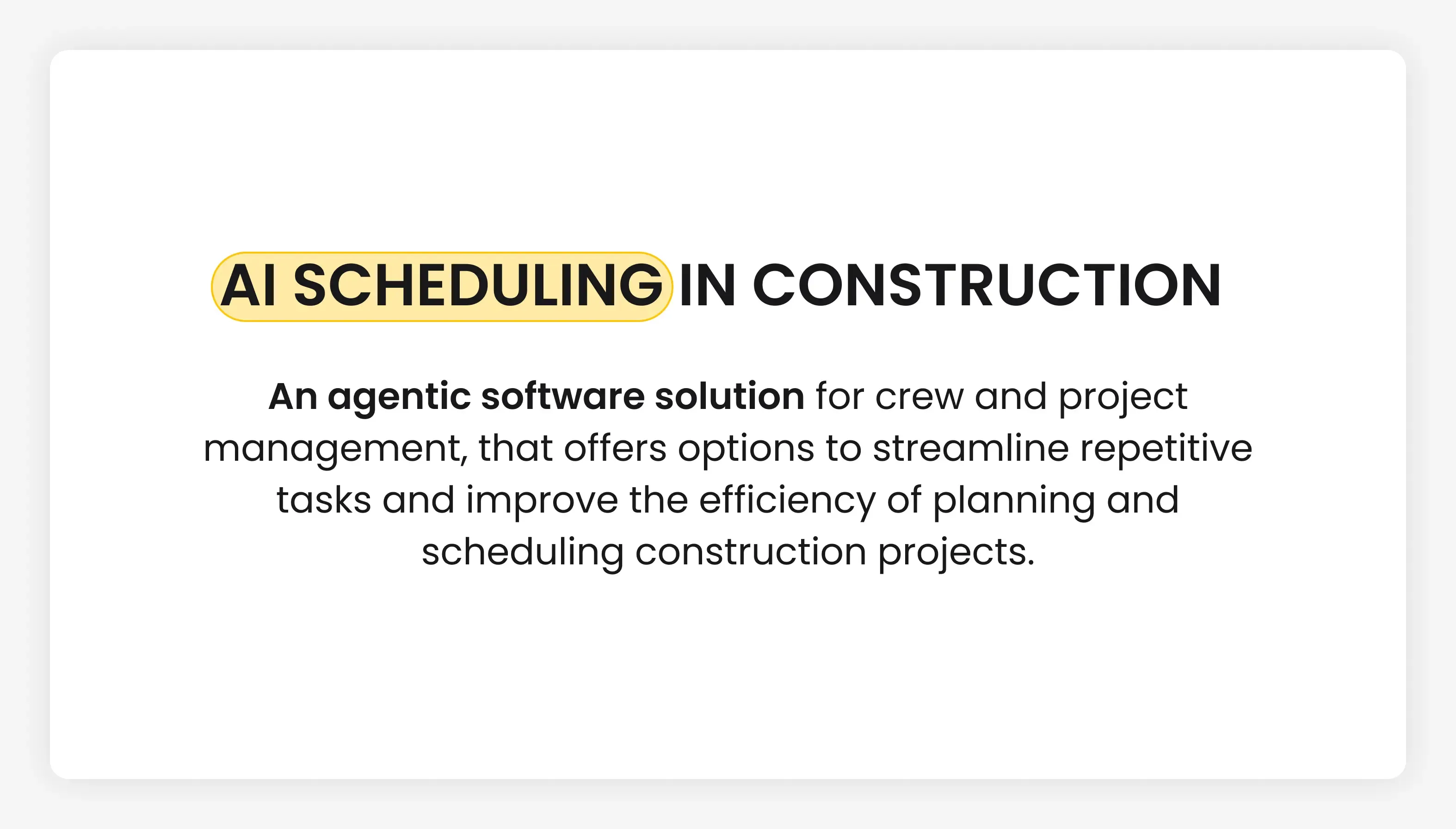
Essentially, AI construction staff scheduling software is comparable to traditional systems for tracking employee or team progress, planning, and task assignment. The primary difference between an AI-driven solution and a more traditional one, such as Peopleforce or Jira, lies in the services they offer and their organizational structure.
For instance, management systems have already started integrating artificial intelligence and similar solutions into their services. However, in these cases, such technologies will work as supplements, extra features, or services.
At the same time, if you choose to develop custom construction project management software development, you have the opportunity to create an AI-first solution that utilizes innovative technologies as its primary operational engine, accessing the full potential of AI agents.
AI shift scheduling can transform a poorly defined, reactive process into a well-organized optimization problem solved in real-time. The system takes in constraints (regulations, union rules, skill/certification requirements), objectives (cost, throughput, fairness), and signals (weather, supply, progress) to coordinate the right people at the right time and in the correct location.
Core AI Workforce Management Features
AI-powered construction staff scheduling software offers a set of non-negotiable capabilities.
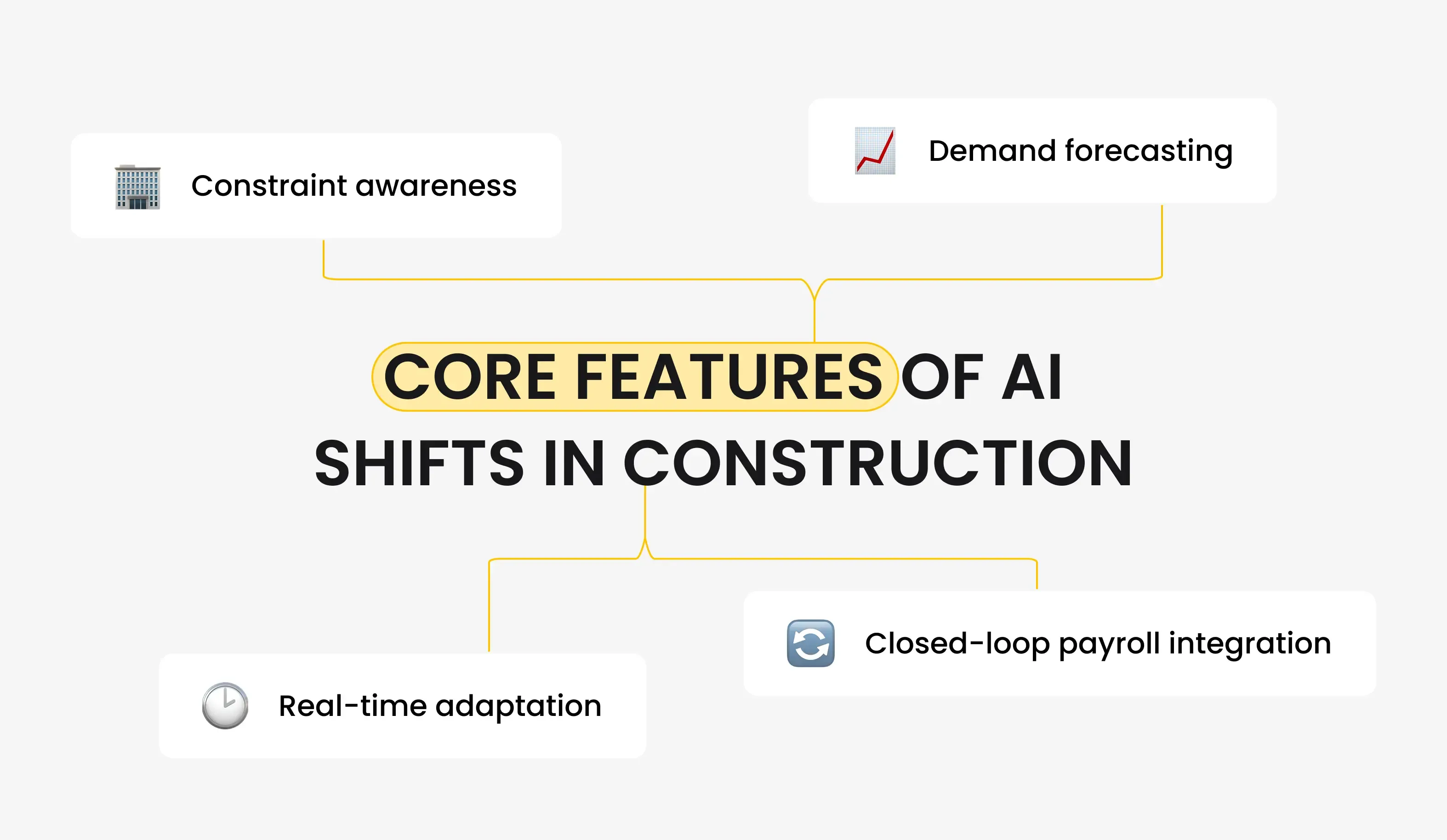
Number one is constraint awareness: the engine naturally honors hour limits, rest periods, and contract provisions, rather than layering them on top afterward.
Number two is demand forecasting: it forecasts labor demands from project schedules, quantities, and historical burn rates, then converts those demands into crews and shifts.
Third is real-time adaptation: if a pour is missed or an inspection fails, the schedule recalculates, suggests alternatives, and sends approvals to supervisors and HR.
Finally, there is closed-loop payroll integration: approved exceptions feed cleanly to pay rules - no rekeying.
Behind the scenes, artificial intelligence combines machine learning with mathematical optimization to manage uncertainty and ensure overall consistency. Ever more commonly, virtual assistants, based on Large Language Models (LLMs), sit atop converting unstructured everyday reports, such as "We lost the crane Wednesday; reshuffle steel and precast crews," into executable schedule revisions with auditable rationale.
Data Inputs and Objective Functions
AI workforce management performance is directly a function of the inputs it is provided. Thanks to integration with other management systems and platforms, this technology can gather and analyze data on plans, schedules, daily reports, and other important information.
Using this data, an AI-driven assistant can make adjustments or make more complex schedule restructuring suggestions that fit the current context, limitations, and circumstances of the project.
As a result, AI-driven construction HR software systems facilitate more accurate estimation and planning, enabling the optimization of budgets and workloads, as well as balancing and prioritizing tasks and objectives, thereby preventing mistakes in team collaboration.
Why Construction is an Ideal Use Case For AI Scheduling?
Sectors such as hospitality and retail were early adopters of automated scheduling, as demand patterns were relatively predictable.
Volatility in the construction industry slowed down adoption, but also makes the potential return on AI investment greater. The more constraints, the more locations, and the more uncertainty, the larger the payoff from a system that can manage them at machine speed.
As a result, even though AI-based construction project management software must be fine-tuned to work effectively under constant pressure and rapidly changing conditions, investing in such solutions can bring numerous benefits and features that help reduce expenses, optimize time management, and achieve higher efficiency by fitting and matching operations with each other.
Let’s consider some more detailed features offered by such systems.
The Compounding Benefits of AI Staff Scheduling
The benefits of AI integration for construction workforce scheduling are realized in two timeframes:
- Short-term wins are achieved in the timeframe to construct the schedule and eliminate payroll errors.
- Structural wins are realized over quarters as overtime is minimized, labor utilization is optimized, and crews become stable.
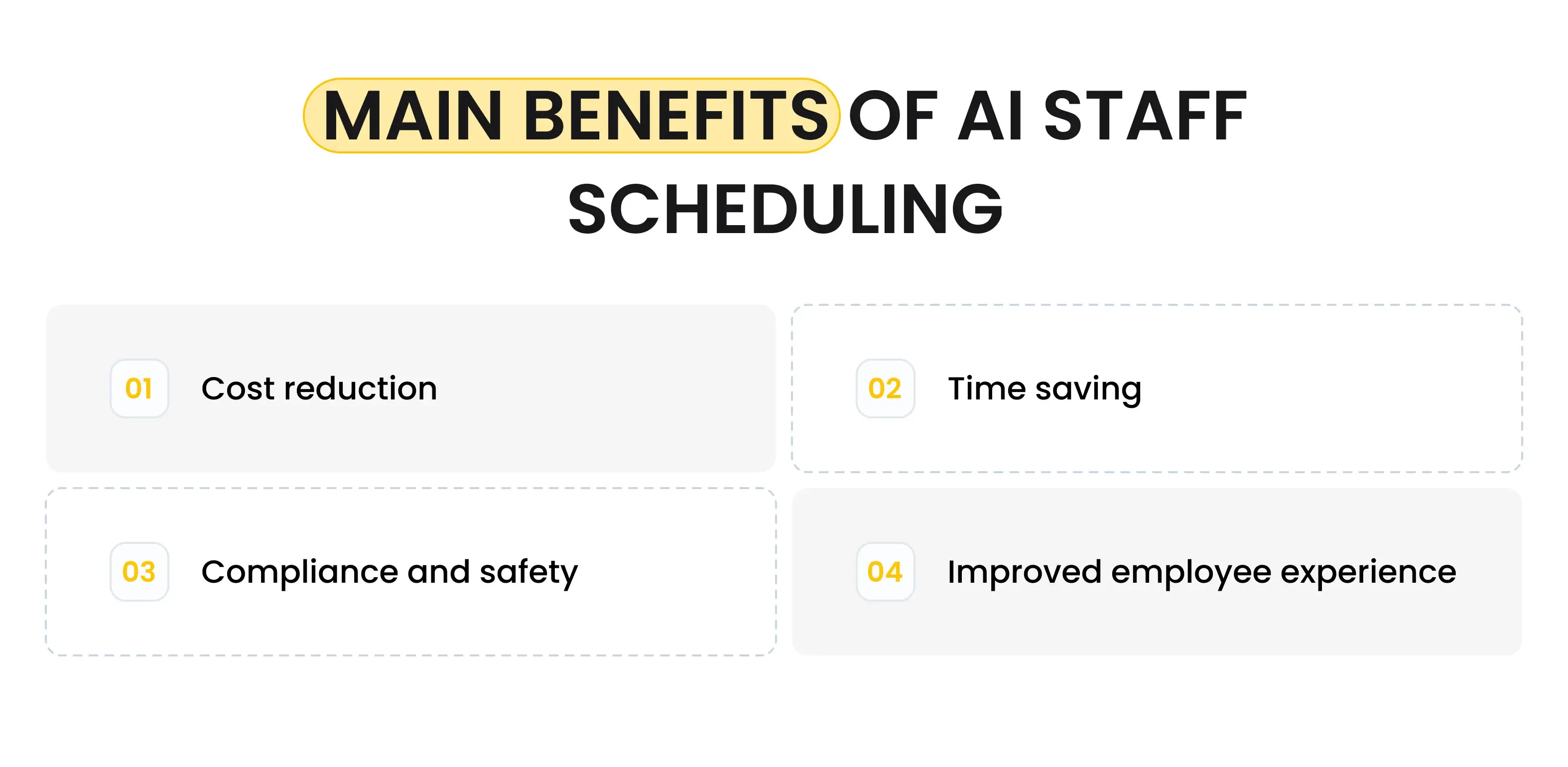
Cost Reduction and Margin Protection
The big headline win is control of labor costs. By having the engine detect over-allocations in advance, it provides substitutions that avoid overtime without impacting throughput.
If the AI system determines that a project will underutilize drywall finishers next week, it suggests reassigning them to a project that begins this phase, thereby minimizing idle spend.
Since approvals and exceptions are digital, payroll leakage due to misapplied premiums or missed differentials is minimized. Across the life of a program, even single-digit utilization gains save margins significantly.
Time Savings for Managers and HR
Schedulers recover hours weekly.
Constructing, publishing, and revising rosters compresses from half-days to minutes. On the back end, HR no longer plays "spreadsheet detective." Purpose-built HR software with AI employee scheduling integration provides precise, audit-ready pay files without marathon reconciliations.
Compliance and Safety by Design
Since compliance regulations reside in the engine, not a book, violations are avoided at scheduling time. The system won't schedule a night shift for a fatigued worker or assign a regulated task without certification coverage.
This minimizes legal exposure and safety incidents. If incidents do happen, the record is clear: who was scheduled, who worked, and who approved a variance.
For additional safety and peace of mind, it is possible to leave the decision-making to the managers. As a result, the AI will generate schedules and other plans, which the assigned employee will then review, approve, or make necessary edits. Therefore, employees can save hours of work time by delegating manual tasks to virtual assistants.
Workforce Experience and Retention
Predictable AI-driven schedules and transparent rotation rules decrease employee turnover.
Mobile self-service, which allows employees to view upcoming shifts, volunteer for overtime, or trade within policy, enhances agency without disruption.
Fairness can be quantified: an artificial intelligence module can spread weekend work across a month, rather than prioritizing the first to respond.
Drawbacks and Risks of AI Scheduling: What to Watch For
Despite overall usability and convenience, AI solutions are not magic. Understanding the risks enables you to design around them from the start and prevent common mistakes or issues.

Cultural Adoption and "Black Box" Trust
Supervisors take pride in solving scheduling conundrums. If a system replaces hard-to-learn heuristics with inscrutable suggestions, adoption is a gradual process.
The solution is explainability: display the rationale why an algorithm ranked Crew B over Crew A ("A over 48 hours; B has cert mix; move saves 12 hours overtime"). Offer one-click supervisor overrides and record rationale to retrain models.
When humans understand how to operate and guide the machine, they utilize it. As a result, in addition to automating manual processes, your team can participate in training and fine-tuning the AI model, making it more accurate and manageable.
Data Quality and Fragmentation
Bad inputs create bad outputs.
Disconnected HRIS, out-of-date project plans, and inconsistent timekeeping will sabotage your AI-based scheduling agent.
Early work must focus on integration and data governance - common IDs, consistent shift codes, and disciplined daily plan updates. You’ll see the benefits of governance in every downstream system, not just scheduling.
Legal and Union Complexity
Contract language encoding is time-consuming.
It must be tested against edge cases (holiday carryover, premium stacking, travel time regulations). Involve labor relations early on.
Collaboratively develop a rules catalog, jointly validate, and maintain a versioned library so that changes are auditable. Don’t hesitate to involve your employees in the system’s testing and provide suggestions for improvement.
The result is a scheduling brain that always plays by your rules.
Cost and Change Management
Software by itself does not change operations. It still requires a budget for training, integration, and rollout support. Prioritize the wins - do not boil the ocean.
With a proper investment, patience, and development approach, you can multiply your ROI in the long run, even if it seems too expensive at first.
A successful pilot that demonstrates overtime reduction or reconciliation speed over time serves as your internal case study for scale.
AI Architecture & Integration: How Everything Fits Together
AI scheduling doesn't achieve its full value unless it is integrated gracefully into the workflow of your operating systems, not independently of them.
The design needs to be modular yet closely integrated to minimize latency and reduce double-entry. Additionally, you must plan and implement efficient and seamless data sharing between internal systems and the chosen AI model.
Data Model and Pipeline Design
Begin with a single worker master: one ID per individual for HR, timekeeping, access control, and payroll purposes. As a result, it would be cheaper to operate and much faster and easier to test the core AI functionality.
Include scheduling-pertinent attributes and stream project demand signals into a normalized schema. Ingest real-time feeds (weather, telematics, delivery ETAs). A lightweight operational data store or lakehouse can serve the AI engine and present clean APIs to other systems, which makes integration easy.
The pipeline must be bi-directional. Schedules generated by the AI engine must be pushed to timekeeping devices and worker apps. Actuals (clock-in/out, site entry) must be pushed back in real-time to reconcile and update the system. Exception events, such as change orders and equipment downtime, must initiate re-optimization.
With a proper approach and clear system logic, you can establish a solid foundation for further scaling of the AI shift scheduling solution.
System Integration Patterns
You’ll likely integrate four classes of systems:
- HRIS
- Payrolls
- Project scheduling sources
- Field systems
HRIS provides demographics, employment status, leave, and compliance documents.
Payroll consumes approved hours and premiums and returns pay confirmations and error flags.
Project scheduling sources inform demand, milestones, and dependencies.
Field systems (time clocks, access control, geofencing, safety apps) confirm reality and campus location.
Leverage existing trends: REST APIs for near real-time exchange, message queues (e.g., Kafka) for event streams, and batch Extract, Transform, Load (ETL) for extensive data processing. To prevent drift and looping updates, you must establish source-of-truth ownership for every data domain.
Mobile and Field User Experience
In-field experience matters the most. Regardless of how valuable and powerful your AI solution is - if your on-site teams don’t use it, the system won’t work as supposed to.
Therefore, you must ensure the most incredible user experience and accessibility of your AI shift scheduling agent, as well as any other software integration. Based on our expertise, management solutions for the construction industry highly depend on mobile and hands-free accessibility.
Consider creating mobile-friendly web designs or standalone mobile apps for your site employees. Another helpful feature, offered directly by AI, is voice recognition technology. Simply put, your employees can make updates without touching their phones and merely voicing them out.
First and foremost, deliver a consistent UX across all projects. Workers shouldn't need to learn a new app for each job.
Security, Privacy, and Compliance
Workforce information is confidential. Encrypt in transit and at rest, implement least-privilege access, and audit who did what and when.
Respect data residency needs and retention durations (e.g., GDPR or other regional/international regulations). For unions and auditors, demonstrating regulatory compliance is just as important as compliance itself - store policy snapshots together with the schedule that was created under them.
A Pragmatic Implementation Roadmap
We have discussed the pros and cons of AI shift scheduling solutions. But how does it happen, and what is the best implementation strategy for such integration?
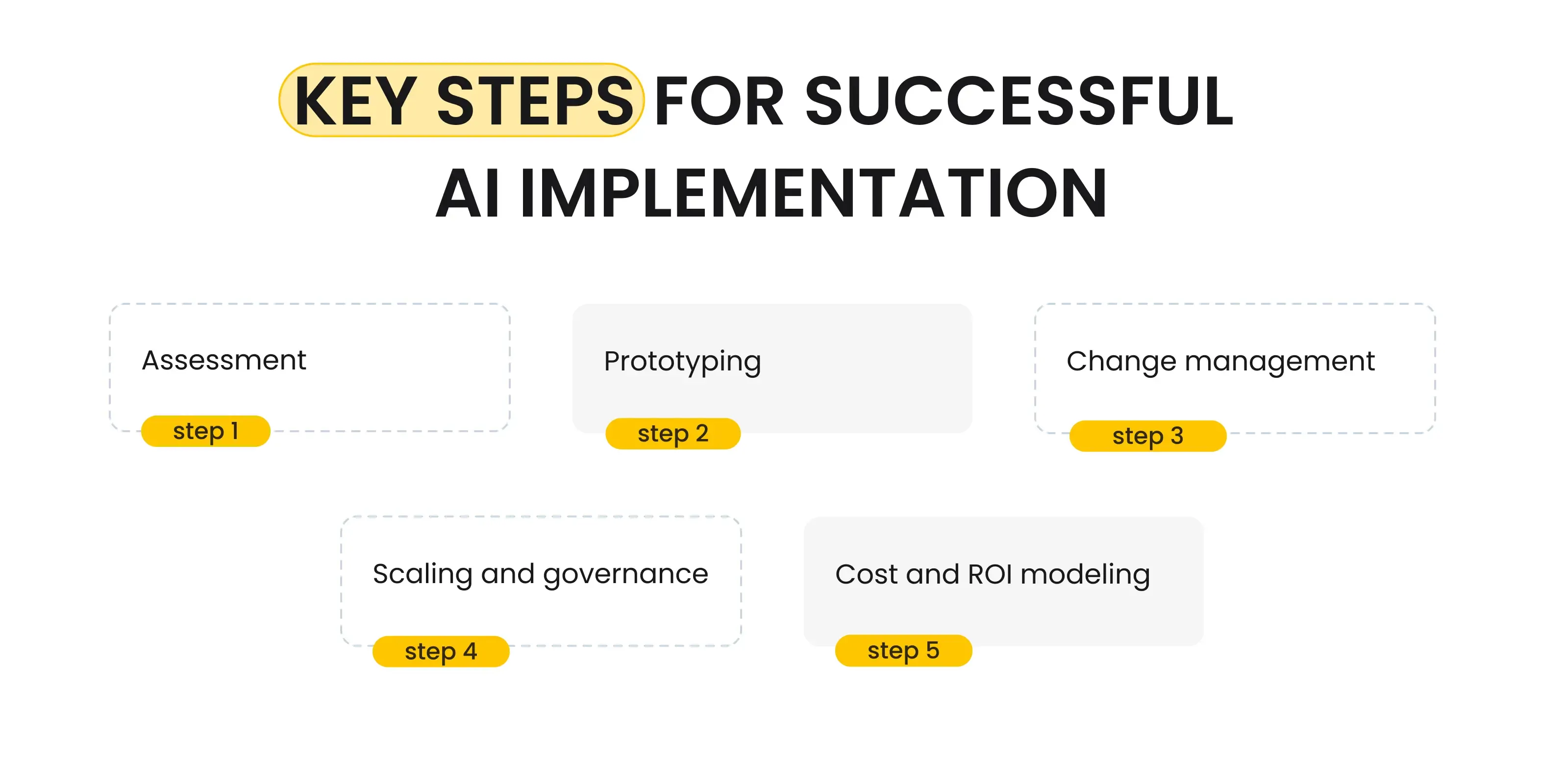
The objective of a roadmap is to demonstrate value early and establish a scalable foundation. Basically, the most basic plan should include the following steps:
- Assessment and business case
- Design pilot and validation tactics
- Change management and training approach
- Scaling and governance plans
- Cost and ROI modeling and estimation
Readiness Assessment and Business Case
Begin by charting your existing scheduling process from start to finish. You should definitely answer the following questions:
- Where is demand generated?
- How are shifts suggested, authorized, and relayed?
- Where are payroll mistakes created?
Additionally, capture baseline metrics, such as scheduling cycle time, percent of hours in overtime, premium expenditure, reconciliation hours in HR, and staff turnover. These metrics will serve as the benchmark for your pilot's achievement and subsequent ROI.
Pilot Design and Validation
Select a representative yet manageable scale, i.e., one area or multi-trade project with actual variability.
Maintain at least one comparable site for legacy practices to facilitate A/B comparison. Operate the AI engine in "shadow mode" for two to four weeks, producing schedules but not implementing them, and compare them with actual outcomes.
In the subsequent stage, allow AI to recommend and managers to approve; monitor overtime, downtime, and exception volume. Audit compliance regulations versus labor relations, and maintain an issue log to optimize the engine's performance over a short period.
Change Management and Training
Treat change as a craft. Communicate the "why" to crews and supervisors, not the "what".
Illustrate explainability: indicate how the system made decisions and where humans are still in control. Focus training for HR and payroll on new exception flows. Have a hypercare window after go-live with rapid response to feedback and visible iteration. Minor quality-of-life enhancements (e.g., more readable shift notifications) generate goodwill.
Scaling and Governance
As you scale, you'll require a governance framework.
Assign a product owner, calendar champions in operations, a data steward, and HR/payroll liaisons. Conduct a monthly rules board to refresh union contracts, premiums, and policy.
Monitor KPIs and release a simple scorecard to demonstrate leadership and the field's progress. Retrain models on your actual data continuously - seasonality, absenteeism trends, and crew performance are all company-specific. Fortunately, ML capabilities help to ensure such AI training with ease.
Cost and ROI Modeling
Cover platform license, integration, and internal change expenses.
Model upside: overtime reduction, reduced reconciliation hours, turnover reduction, lower idle payroll, and increased on-time task completions. Payback in under a year is typical for contractors when implemented across a sufficiently complex portfolio.
Your baseline metrics from the assessment phase will allow you to demonstrate it credibly.
Measuring Success: KPIs That Matter
You can't control what you don't track. Agree on some KPIs, automate their collection, and discuss them monthly.
Scheduling and Cost KPIs
Measure the schedule cycle time to track from demand capture to published plan; the goal is minutes, not days. Measure overtime as a percent of hours; the goal is a consistent declining trend. Measure idle hours (paid time without productive work) and the premium error rate in payroll.
These overall indicate cost control and process maturity.
Compliance and Safety KPIs
Measure scheduling rule violations avoided at the time of scheduling - a leading indicator. Monitor compliance with the fatigue rule and certification coverage.
Transparency builds trust with unions and regulators.
Workforce Experience KPIs
Monitor schedule notice lead time, swap approval turnaround times, and perceived fairness through surveys. It helps to trend voluntary turnover by craft and location, along with schedule stability.
As predictability and fairness improve, retention rates also improve.
Vendor & Partner Evaluation Checklist
Ultimately, your tech partner plays a vital role in securing and succeeding with AI-driven shift scheduling integration. If selected properly, your AI business automation companion will cover almost the entire project, leaving you to make the decisions and clarify the requirements.
Here is a brief list of markers that signify you're dealing with a proper software solution or development team:
- Scheduling depth and explainability
- Integration competence and data model fit
- Field-first user experience
- Compliance engine and auditability
- Security and trust
- Change management and success rate
Scheduling Depth and Explainability
Seek out engines that represent multi-objective optimization (cost, throughput, fairness) with interpretable explanations for each assignment. Request a demonstration of how the tool explains a substitution, enforces constraints, and logs overrides for learning.
Integration Competence and Data Model Fit
Require existing connectors or establish patterns for your HRIS, payroll, project scheduling software, and timekeeping hardware. Examine the worker master schema to determine if it supports your certifications, premiums, and union attributes. Attempt round-trip flows: published schedules out; attendance and exceptions in.
Field-First User Experience
Require mobile UX you can be proud to roll out: offline functionality, smart notifications, easy trades, and supervisor approvals that function in a filthy trailer with poor Wi-Fi. Test with actual crews; pay close attention to their input.
Compliance Engine and Auditability
Request a demonstration of how labor laws are encoded, versioned, and tested. Walk through an audit: "Show me the policy snapshot and schedule created under it for Week 32."
If the vendor cannot do this gracefully, continue your search.
Security and Trust
Demand encryption, SSO/MFA, granular role-based access, and full audit trails. Verify data residency options and retention controls that align with your legal landscape and client obligations.
Change Management and Success Services
Software alone is insufficient. Examine the partner's strategy for training, hypercare, KPI reporting, and governance establishment. Ask for playbooks and actual customer feedback in which frontline adoption - not merely go-live - was realized.
If everything above meets your satisfaction and aligns with your business policies, congratulations! You have found the perfect candidate.
A Day in the Life with AI Construction Employee Scheduling
Consider Tuesday, 5:30 a.m. The forecast evolves: gusts will surpass crane tolerances at noon.
The AI employee scheduling engine recalculates: heavy pickings are rescheduled to early morning, interior task assignments are rescheduled forward, and one finishing crew is reassigned to a nearby site to absorb slack.
Supervisors are presented with a single approval screen that summarizes changes and their corresponding reasons. New start times and locations are sent to employees, along with travel instructions.
HR does not experience an explosion of exceptions - pay codes are streamed automatically.
By 7:00 a.m., the day is back to normal without a frantic phone tree or additional expense. Multiply that peace of mind by 200 workdays, and you have the form of your ROI.
Why Incora Is the Right Partner - And What You’ll Get
Choosing the right partner determines whether AI construction employee scheduling becomes a daily advantage or another shelved pilot. Incora's software team specializes in AI workforce management for the construction industry, with multiple successful cases in both construction development and AI integration.
What Makes Incora Different?
We begin by listening - tracing your specific union rules, premiums, and certification landscape. Then we translate them into a readable rules engine that your team owns and maintains.
Our developers create data models and real-time pipelines that seamlessly integrate project schedules, HRIS, payroll, and timekeeping systems, eliminating the need for duct tape.
Our UX team creates field-first mobile experiences that function offline, enabling supervisors to maintain control.
Our change managers adhere to a formalized adoption program, which includes training, hypercare, and KPI dashboards, to demonstrate value and establish trust.
With Incora, you can anticipate quantifiable decreases in overtime and reconciliation effort. Your executives receive leading indicators of risk sooner, and your site teams manage less and build more. If you’re ready to move beyond spreadsheets and firefighting to a world where schedules are predictive, it’s time to talk to Incora.
Book a discovery session with Incora to:
- Map your existing scheduling, HR, and payroll processes and baseline KPIs.
- View a demo of AI scheduling using your actual rules and constraints - no black boxes.
- Create a pilot that validates overtime reduction, reconciliation speed, and schedule fairness.
- Build the integration roadmap that makes AI a daily operational benefit.
- Implement changes with ease.
What’s your impression after reading this?
Love it!
23
Valuable
7
Exciting
5
Unsatisfied
1
FAQ
Let us address your doubts and clarify key points from the article for better understanding.
What is AI shift scheduling and how does it benefit construction projects?
AI shift scheduling automates workforce planning by using real-time data and forecasts to optimize labor allocation, reduce errors, cut overtime costs, and improve project efficiency.
How does AI scheduling improve compliance in construction workforce management?
AI scheduling systems automatically enforce labor laws, rest periods, certifications, and union rules during scheduling, reducing legal risks and ensuring adherence to complex regulations.
Can AI shift scheduling adapt to unexpected changes on construction sites?
Yes, AI-powered scheduling dynamically recalculates and adjusts shifts in real-time based on site disruptions like weather delays or equipment failures, maintaining productivity and minimizing downtime.
What integration is required for AI scheduling in construction companies?
Effective AI scheduling integrates with HRIS, payroll, project management software, and field devices to streamline data flow, automate payroll reconciliation, and enhance workforce management.
What are typical ROI benefits from implementing AI shift scheduling?
Companies typically see reduced overtime expenses, faster schedule creation, lower payroll errors, improved workforce stability, and a payback period often under one year.
you may also like
Management Systems
Construction Project Management Software for Small Business: Complete Guide
Construction
How AI Negotiation Agents Improve Construction Procurement [And Why Do You Need It]
Construction,
Real Estate
How Construction Workflow Management Software Helps to Reduce Costs and Boost Efficiency?
Construction
How Integrated BOQ Software Bridges the Gap Between Construction Departments
Construction
How to Create a Procore Alternative Software for a Construction Business
Construction
How to Deal With Weaknesses of Construction Financial Management Software?
Real Estate
How to Select the Right Construction Management Software for Your Business
Construction
Investing in the Right Construction Reporting Software: Features That Make a Difference
Construction
Is Voice Technology Worth the Investment for Construction Firms?
Construction
Overcoming Integration Challenges: Making Construction Data Work Together with BI Tools
Management Systems
Simple Construction Software for Construction Planning: Case Study
Construction
The Complete Guide to AI Construction Document Review for Project Management
Let's talk!
This site uses cookies to improve your user experience. Read our Privacy Policy
Accept
Share this article